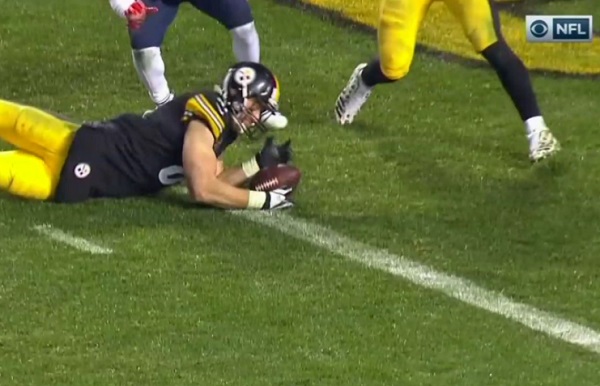NFL Catch Rule vs College Football Catch Rule

Unless you live under a rock, you have heard something about the NFL catch rule over the last few days. “He caught it.” “What a stupid rule.” “Quit crying.” Or something to that extent.
Jesse James caught an apparent game-winning touchdown for the Pittsburgh Steelers against the New England Patriots. Steelers fans everywhere went nuts. Even when they showed the replay Jim Nantz and Tony Romo were still dropping the ball (pun not intended). They thought the refs were checking whether or not James made it into the end zone. After reviewing it about ten times, Romo finally realized what the refs were looking at. The ball came loose while James was going to the ground or “completing the catch” as you may have heard.
Take a look. Let NFL Football Operations break it down for you.
The video is an explanation from @NFL SVP of Officiating Al Riveron on the reversal at the end of the #NEvsPIT game. pic.twitter.com/hm5EeoZTER
— NFL Football Operations (@NFLFootballOps) December 18, 2017
“BUT HE HAD THE BALL IN THE END ZONE.”
Let this smart man break it down for you as well.
https://www.youtube.com/watch?v=4L6f54-_TrI
The ruling had nothing to do with “breaking the plane” or “getting in the end zone.” It was ruled incomplete. Whether or not James was in the end zone was irrelevant to the ruling.
From the Official NFL Rulebook:
Item 1. Player Going to the Ground. A player is considered to be going to the ground if he does not remain upright long enough to demonstrate that he is clearly a runner. If a player goes to the ground in the act of catching a pass (with or without contact by an opponent), he must maintain control of the ball until after his initial contact with the ground, whether in the field of play or the end zone. If he loses control of the ball, and the ball touches the ground before he regains control, the pass is incomplete. If he regains control prior to the ball touching the ground, the pass is complete.
You may have heard many announcers say this was a touchdown in high school football or College Football Why is that? Well that’s because in those leagues runners don’t have to be touched to be declared down. Tony Dungy said this loud and clear on Sunday Night Football.
So what is the rule in college football?
Per the NCAA Football Rules:
Catch, Interception, Recovery ARTICLE 3. a. To catch a ball means that a player:
1. Secures control of a live ball in flight before the ball touches the ground, and
2. Touches the ground in bounds with any part of his body, and then
3. Maintains control of the ball long enough to enable him to perform an act common to the game, i.e., long enough to pitch or hand the ball, advance it, avoid or ward off an opponent, etc., and
4. Satisfies paragraphs b, c, and d below.
b. If a player goes to the ground in the act of catching a pass (with or without contact by an opponent) he must maintain complete and continuous control of the ball throughout the process of contacting the ground, whether in the field of play or in the end zone. This is also required for a player attempting to make a catch at the sideline and going to the ground out of bounds. If he loses control of the ball which then touches the ground before he regains control, it is not a catch. If he regains control inbounds prior to the ball touching the ground it is a catch.
c. If the player loses control of the ball while simultaneously touching the ground with any part of his body, or if there is doubt that the acts were simultaneous, it is not a catch. If a player has control of the ball, a slight movement of the ball, even if it touches the ground, will not be considered loss of possession; he must lose control of the ball in order for there to be a loss of possession.
d. If the ball touches the ground after the player secures control and continues to maintain control, and the elements above are satisfied, it is a catch.
So this begs the question. Would this have been a catch in college football?
If you listened to every NFL analyst, they would lead you to believe this ruling was exclusive to the NFL. If you look at 4B above, you see the following excerpt:
If a player goes to the ground in the act of catching a pass (with or without contact by an opponent) he must maintain complete and continuous control of the ball throughout the process of contacting the ground, whether in the field of play or in the end zone. This is also required for a player attempting to make a catch at the sideline and going to the ground out of bounds. If he loses control of the ball which then touches the ground before he regains control, it is not a catch. If he regains control inbounds prior to the ball touching the ground it is a catch.
So if you go by the official rulebook, this would not have been a catch in NFL or College Football. Tony Dungy was wrong.
The glaring difference between the NFL and College Football ruling is that a player needs to get only one foot down inbounds.
Am I wrong? I’d love to hear about it. Tell me your thoughts in the Facebook comments section.
